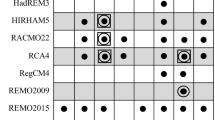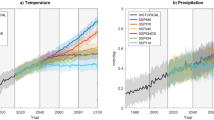Abstract
This study investigates the global warming response of the Walker Circulation and the other zonal circulation cells (represented by the zonal stream function), in CMIP3 and CMIP5 climate models. The changes in the mean state are presented as well as the changes in the modes of variability. The mean zonal circulation weakens in the multi model ensembles nearly everywhere along the equator under both the RCP4.5 and SRES A1B scenarios. Over the Pacific the Walker Circulation also shows a significant eastward shift. These changes in the mean circulation are very similar to the leading mode of interannual variability in the tropical zonal circulation cells, which is dominated by El Niño Southern Oscillation variability. During an El Niño event the circulation weakens and the rising branch over the Maritime Continent shifts to the east in comparison to neutral conditions (vice versa for a La Niña event). Two-thirds of the global warming forced trend of the Walker Circulation can be explained by a long-term trend in this interannual variability pattern, i.e. a shift towards more El Niño-like conditions in the multi-model mean under global warming. Further, interannual variability in the zonal circulation exhibits an asymmetry between El Niño and La Niña events. El Niño anomalies are located more to the east compared with La Niña anomalies. Consistent with this asymmetry we find a shift to the east of the dominant mode of variability of zonal stream function under global warming. All these results vary among the individual models, but the multi model ensembles of CMIP3 and CMIP5 show in nearly all aspects very similar results, which underline the robustness of these results. The observed data (ERA Interim reanalysis) from 1979 to 2012 shows a westward shift and strengthening of the Walker Circulation. This is opposite to what the results in the CMIP models reveal. However, 75 % of the trend of the Walker Circulation can again be explained by a shift of the dominant mode of variability, but here towards more La Niña-like conditions. Thus in both climate change projections and observations the long-term trends of the Walker Circulation seem to follow to a large part the pre-existing dominant mode of internal variability.














Similar content being viewed by others
References
Bayr T, Dommenget D (2013a) The tropospheric land-sea warming contrast as the driver of tropical sea level pressure changes. J Clim 26:1387–1402. doi:10.1175/JCLI-D-11-00731.1
Bayr T, Dommenget D (2013b) Comparing the spatial structure of variability in two datasets against each other on the basis of EOF-modes. Clim Dyn. doi:10.1007/s00382-013-1708-x
Bengtsson L, Hodges KI (2009) On the evaluation of temperature trends in the tropical troposphere. Clim Dyn 36:419–430. doi:10.1007/s00382-009-0680-y
Bretherton CS, Widmann M, Dymnikov VP, Wallace JM, Bladé I (1999) The effective number of spatial degrees of freedom of a time-varying field. J Clim 12:1990–2009
Clement AC, Seager R, Cane MA, Zebiak SE (1996) An ocean dynamical thermostat. J Clim 9:2190–2196
DiNezio PN, Clement AC, Vecchi GA, Soden BJ, Kirtman BP, Lee S-K (2009) Climate response of the equatorial pacific to global warming. J Clim 22:4873–4892. doi:10.1175/2009JCLI2982.1
DiNezio PN, Clement A, Vecchi GA, Soden B, Broccoli AJ, Otto-Bliesner BL, Braconnot P (2011) The response of the Walker circulation to Last Glacial Maximum forcing: Implications for detection in proxies. Paleoceanography 26. doi:10.1029/2010PA002083
DiNezio PN, Vecchi GA, Clement AC (2013) Detectability of changes in the Walker circulation in response to global warming. J Clim 130114154537002, doi:10.1175/JCLI-D-12-00531.1
Dommenget D, Bayr T, Frauen C (2013) Analysis of the non-linearity in the pattern and time evolution of El Niño southern oscillation. Clim Dyn 40:2825–2847. doi:10.1007/s00382-012-1475-0
Frauen C, Dommenget D (2010) El Niño and La Niña amplitude asymmetry caused by atmospheric feedbacks. Geophys Res Lett 37:L18801. doi:10.1029/2010GL044444
Haarsma RJ, Selten F (2012) Anthropogenic changes in the Walker circulation and their impact on the extra-tropical planetary wave structure in the Northern Hemisphere. Clim Dyn. doi:10.1007/s00382-012-1308-1
Hastenrath S (1985) Climate and circulation of the tropics. D. Reisel Publishing Company, Dordrecht
Held IM, Soden BJ (2006) Robust responses of the hydrological cycle to global warming. J Clim 19:5686–5699. doi:10.1175/JCLI3990.1
Hoerling MP, Kumar A, Zhong M (1997) El Niño, La Niña, and the nonlinearity of their teleconnections. J Clim 10:1769–1786. doi:10.1175/1520-0442(1997)010<1769:ENOLNA>2.0.CO;2
Kang I-S, Kug J-S (2002) El Niño and La Niña sea surface temperature anomalies: asymmetry characteristics associated with their wind stress anomalies. J Geophys Res 107:4372. doi:10.1029/2001JD000393
Knutson TR, Manabe S (1995) Time-mean response over the tropical Pacific to increased c0 2 in a coupled ocean-atmosphere model. J Clim 8:2181–2199. doi:10.1175/1520-0442(1995)008<2181:TMROTT>2.0.CO;2
Kosaka Y, Xie S-P (2013) Recent global-warming hiatus tied to equatorial Pacific surface cooling. Nature. doi:10.1038/nature12534
Latif, M, Keenlyside NS (2009) El Niño/Southern Oscillation response to global warming. Proc Natl Acad Sci 106(49): 20578–20583
L’Heureux ML, Lee S, Lyon B (2013) Recent multidecadal strengthening of the Walker circulation across the tropical Pacific. Nat Clim Change 3:1–6. doi:10.1038/nclimate1840
Luo J–J, Sasaki W, Masumoto Y (2012) Indian Ocean warming modulates Pacific climate change. Natl Acad Sci, Proc. doi:10.1073/pnas.1210239109
Meehl G, Washington W (1996) El Niño-like climate change in a model with increased atmospheric CO 2 concentrations. Nature 382:56–60
Meehl GA, Covey C, Delworth T, Latif M, McAvaney B, Mitchell JFB, Stouffer RJ, Taylor KE (2007) THE WCRP CMIP3 multimodel dataset: a new era in climate change research. Bull Am Meteorol Soc 88:1383. doi:10.1175/BAMS-88-9-1383
Meng Q, Latif M, Park W, Keenlyside NS, Semenov VA, Martin T (2011) Twentieth century Walker Circulation change: data analysis and model experiments. Clim Dyn 1–17. doi:10.1007/s00382-011-1047-8
North GR, Bell TL, Cahalan RF (1982) Sampling errors in the estimation of empirical orthogonal functions. Mon Weather Rev 110:699–706
Philander S (1990) El Niño, La Niña, and the southern oscillation. Academic, San Diego
Philip S, van Oldenborgh GJ (2009) Significant atmospheric nonlinearities in the ENSO Cycle. J Clim 22:4014–4028. doi:10.1175/2009JCLI2716.1
Power SB, Kociuba G (2010) The impact of global warming on the Southern Oscillation Index. Clim Dyn 37:1745–1754. doi:10.1007/s00382-010-0951-7
Power SB, Kociuba G (2011) What caused the observed 20th century weakening of the Walker circulation? J Clim. 110629145325000. doi:10.1175/2011JCLI4101.1
Power S, Casey T, Folland C, Colman A, Mehta V (1999) Inter-decadal modulation of the impact of ENSO on Australia. Clim Dyn 15:319–324
Rodgers KB, Friederichs P, Latif M (2004) Tropical Pacific decadal variability and its relation to decadal modulations of ENSO. J Clim 17:3761–3774. doi:10.1175/1520-0442(2004)017<3761:TPDVAI>2.0.CO;2
Schwendike J, Govekar P, Reeder MJ, Wardle R, Berry GJ, Jakob C (2014) Local partitioning of the overturning circulation in the tropics and the connection to the Hadley and Walker circulation. J Geophys Res Atmos. doi:10.1002/2013JD020742
Simmons A, Uppala S, Dee D, Kobayashi S (2007) ERA-Interim: new ECMWF reanalysis products from 1989 onwards. ECMWF Newsl 110:25–35
Singh MS, O’Gorman PA (2012) Upward shift of the atmospheric general circulation under global warming: theory and Simulations. J Clim 25:8259–8276. doi:10.1175/JCLI-D-11-00699.1
Sohn BJ, Park S-C (2010) Strengthened tropical circulations in past three decades inferred from water vapor transport. J Geophys Res 115:D15112. doi:10.1029/2009JD013713
Solomon A, Newman M (2012) Reconciling disparate twentieth-century Indo-Pacific ocean temperature trends in the instrumental record. Nat Clim Change 2:691–699. doi:10.1038/nclimate1591
Taylor KE, Stouffer RJ, Meehl GA (2012) An overview of CMIP5 and the experiment design. Bull Am Meteorol Soc 93:485–498. doi:10.1175/BAMS-D-11-00094.1
Tokinaga H, Xie S-P, Deser C, Kosaka Y, Okumura YM (2012a) Slowdown of the Walker circulation driven by tropical Indo-Pacific warming. Nature 491:439–443. doi:10.1038/nature11576
Tokinaga H, Xie S-P, Timmermann A, McGregor S, Ogata T, Kubota H, Okumura YM (2012b) Regional patterns of tropical Indo-Pacific climate change: evidence of the Walker circulation weakening*. J Clim 25:1689–1710. doi:10.1175/JCLI-D-11-00263.1
Vecchi GA, Soden BJ (2007) Global warming and the weakening of the tropical circulation. J Clim 20:4316–4340. doi:10.1175/JCLI4258.1
Vecchi GA, Soden BJ, Wittenberg AT, Held IM, Leetmaa A, Harrison MJ (2006) Weakening of tropical Pacific atmospheric circulation due to anthropogenic forcing. Nature 441:73–76. doi:10.1038/nature04744
Yu J-Y, Kim ST (2011) Reversed spatial asymmetries between El Niño and La Niña and their linkage to decadal ENSO modulation in CMIP3 models. J Clim. 110506133859050. doi:10.1175/JCLI-D-11-0024.1
Yu B, Zwiers FW (2010) Changes in equatorial atmospheric zonal circulations in recent decades. Geophys Res Lett 37:L05701
Yu B, Zwiers FW, Boer GJ, Ting MF (2012) Structure and variances of equatorial zonal circulation in a multimodel ensemble. Clim Dyn. doi:10.1007/s00382-012-1372-6
Acknowledgments
We acknowledge the World Climate Research Program’s Working Group on Coupled Modeling, the individual modeling groups of the Climate Model Intercomparison Project (CMIP3 and CMIP5) and ECMWF for providing the data sets. This work was supported by the Deutsche Forschungsgemeinschaft (DFG) through project DO1038/5-1, the ARC Centre of Excellence in Climate System Science (CE110001028), the ARC project “Beyond the linear dynamics of the El Nino Southern Oscillation” (DP120101442), the RACE Project of BMBF, the NACLIM Project of the European Union and the Australian Climate Change Science Program. We thank Hanh Nguyen for providing the code to calculate the zonal stream function and Hardi Bordbar, Sabine Haase and the anonymous reviewers for discussion and useful comments.
Author information
Authors and Affiliations
Corresponding author
Rights and permissions
About this article
Cite this article
Bayr, T., Dommenget, D., Martin, T. et al. The eastward shift of the Walker Circulation in response to global warming and its relationship to ENSO variability. Clim Dyn 43, 2747–2763 (2014). https://doi.org/10.1007/s00382-014-2091-y
Received:
Accepted:
Published:
Issue Date:
DOI: https://doi.org/10.1007/s00382-014-2091-y




